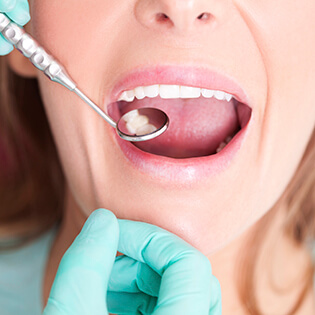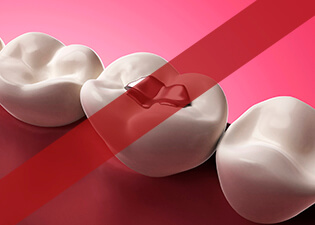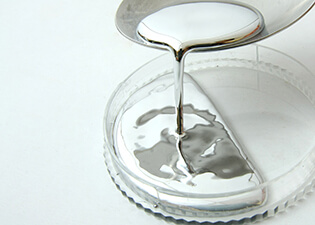Mercury-Free Dentistry
 Mercury-based amalgam (silver) filling material is not used in our practice. Our patients are instead provided composite resin fillings that can wear at similar rates to iron and other metals, and provide excellent color matching and shading characteristics that match premium grades of porcelain restoratives (overlays, inlays, veneers, and crowns). Our practice has promoted mercury-free dental treatments for many decades, choosing instead to use leading-edge composite resin products for routine dental fillings, repairing chipped teeth, and tooth reshaping. For some patients, composite material is an affordable and durable alternative for veneers.
Mercury-based amalgam (silver) filling material is not used in our practice. Our patients are instead provided composite resin fillings that can wear at similar rates to iron and other metals, and provide excellent color matching and shading characteristics that match premium grades of porcelain restoratives (overlays, inlays, veneers, and crowns). Our practice has promoted mercury-free dental treatments for many decades, choosing instead to use leading-edge composite resin products for routine dental fillings, repairing chipped teeth, and tooth reshaping. For some patients, composite material is an affordable and durable alternative for veneers.
 Historical Perspective
Historical Perspective
Published research demonstrates that mercury is more toxic than lead, cadmium, or arsenic. Due to its poisonous nature, mercury can adversely affect the immune, urinary, cardiac, respiratory, and digestive systems. Under laboratory conditions, mercury has produced brain cell deterioration identical to that seen in victims of Alzheimer's Disease. Mercury poisoning has been implicated in immune system suppression, multiple sclerosis, depression, chronic fatigue syndrome, and autism.
A large amalgam filling may contain as much mercury as a thermometer. Mercury vaporizes easily at room temperature and in this state, is odorless, colorless, and tasteless. Inhaled, mercury vapor is readily absorbed into the bloodstream. No amount of mercury vapor can be considered harmless, especially considering its cumulative effect.
 Biocompatibility Preferences
Biocompatibility Preferences
Principles of minimally invasive and non-invasive treatments in both medicine and dentistry continue to develop at a geometric rate. Due to our team’s commitment to excellence in every aspect of dentistry, our patients enjoy having the option to replace older, accepted standards with advanced standards of care.
Just as titanium, zirconia, and advanced prosthetic acrylics have replaced outdated product technologies in tooth replacement dentistry, the biocompatibility of tooth-colored composites is redefining the functional and cosmetic longevity of teeth before ultimate failure and need for replacement.
Protocol: Safe, Healthful Amalgam Removal
To prevent additional mercury exposure for our patients and team, Dr. Petulla and Dr. Kazemi use a specific protocol for assuring successful and uneventful treatment:
- Utilizing an effective oral suction system to contain amalgam particles and limit mercury vapors
- A rubber dam to isolate and prevent swallowing debris
- Operating a vacuum system at optimal efficiency
- Applying copious amounts of water to the filling during removal
- Removing large portions of the amalgam to minimize particulate and mercury vapor release
- Providing a safe source of oxygen for the patient to breathe during removal
 Composite Resin Replacements
Composite Resin Replacements
Advancements in dental chemistry have led to the development of many different types of composite resin products that can be used for new fillings and filling replacements. Bonding characteristics and even the molecular properties can vary, affecting the cosmetic value and long term endurance of tooth fillings.
 Filling Replacement Failures
Filling Replacement Failures
Unfortunately, many patients report newfound pain and sensitivity issues associated with amalgam filling replacements. During retreatment, extremely deep cavities can be a potential problem area for nearly any patient. Technical errors that are associated more with the actual use of resin products that can cause cracking and eventual leakage are best controlled by strict adherence to the treatment protocol defined by the manufacturer of the product.
The use of advanced composites requires attention to detail that was not required with old fashioned amalgam fillings. Moisture control, cross contamination, cumulative layering for deep fillings, and the use of special etching compounds are monitored closely by our doctors, thereby eliminating the most common complaints associated with changing old tooth fillings.
Questions?
Patients who have questions about the material on this page or other amalgam filling questions are invited to contact Dr. Petulla or Dr. Kazemi directly with our on-line Ask the Dentist form.
